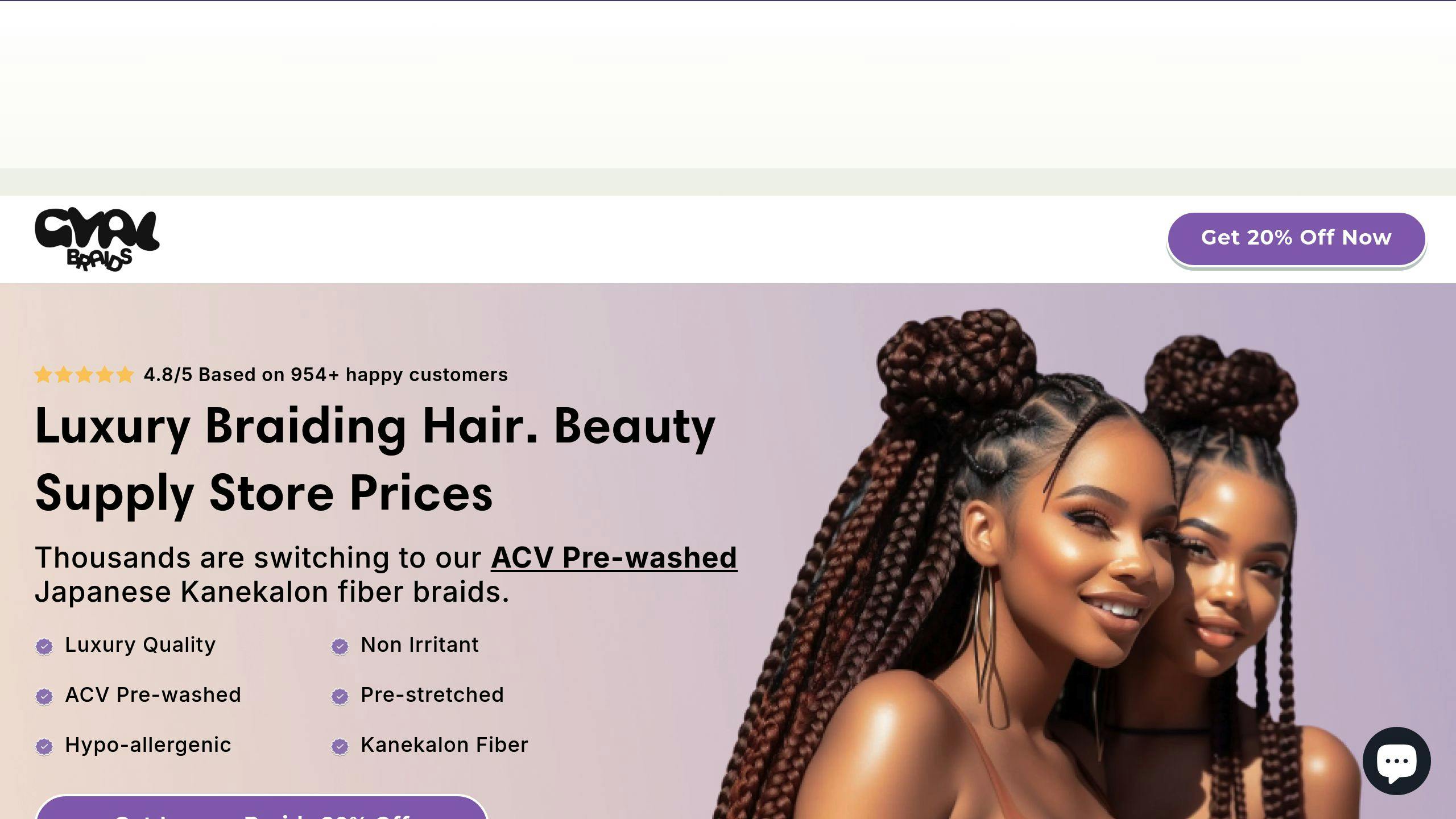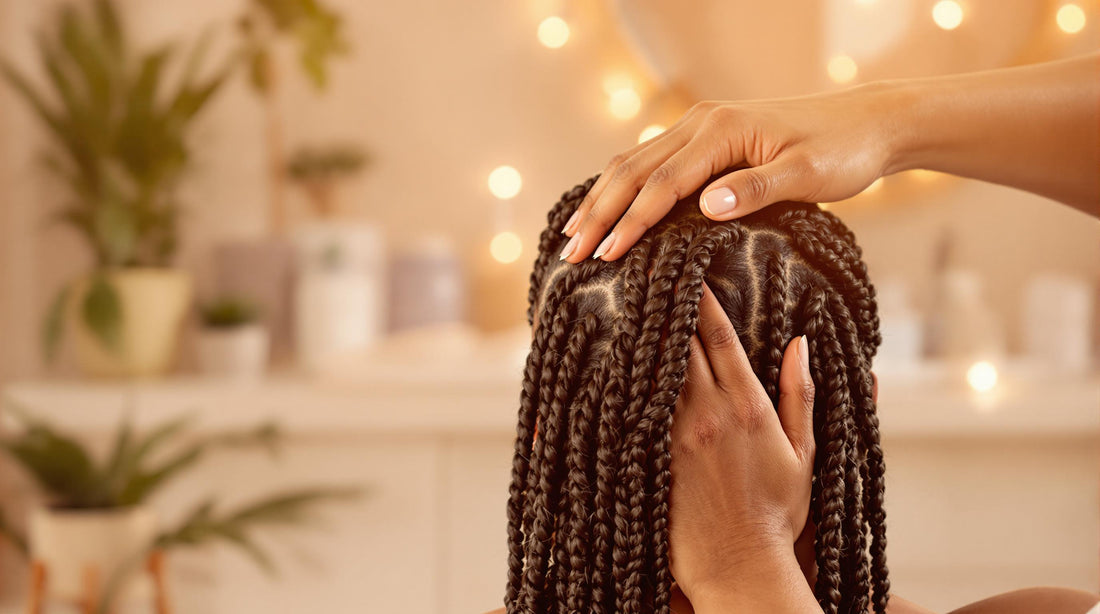Struggling with itching from synthetic braids? Here's how to fix it:
- Pre-wash synthetic hair: Soak in apple cider vinegar and water to remove irritants.
- Moisturize your scalp: Use lightweight oils 2–3 times a week to keep dryness away.
- Wash regularly: Clean your scalp every 2–3 weeks with a clarifying shampoo to prevent buildup.
- Choose hypoallergenic hair: Opt for pre-washed, chemical-free braiding hair to reduce irritation.
Itching is often caused by chemical coatings or allergic reactions to synthetic materials. Follow these steps to protect your scalp and enjoy a comfortable braiding experience.
How to Completely Stop the Itch in Protective Styles: Causes and Solutions
What Causes Itching from Synthetic Braids?
Itching from synthetic braids can be frustrating, but knowing the main causes can help you address the problem effectively. Two major culprits are responsible for scalp irritation when wearing synthetic braids.
Chemical Coatings on Braiding Hair
Synthetic braiding hair is often treated with alkaline-based chemicals during manufacturing. These chemicals help the hair retain its shape and texture but can irritate the scalp, leading to itching and discomfort.
Allergic Reactions to Synthetic Materials
Materials like kanekalon and toyokalon, commonly used in synthetic braids, can cause allergic reactions for some individuals. Prolonged contact with these fibers may result in symptoms such as itching, redness, or even inflammation.
| Symptom | What to Do |
|---|---|
| Mild Itching | Try anti-itch products and monitor the scalp |
| Redness & Irritation | Pre-wash hair before your next installation |
| Burning Sensation | Remove braids and consult a professional |
| Scalp Inflammation | Seek immediate medical care |
If left unchecked, these reactions can escalate into more serious issues, like traction alopecia - a condition where the hair follicles are damaged due to continuous irritation and tension [2]. Opting for pre-washed braiding hair can significantly reduce the risk of these problems.
Taking steps like pre-washing synthetic hair can make a big difference in preventing scalp irritation and ensuring a more comfortable experience.
How to Pre-Wash Synthetic Hair to Prevent Itching
Using Apple Cider Vinegar to Remove Chemicals
Synthetic braiding hair often comes with a chemical coating that can cause itching. Pre-washing it with apple cider vinegar (ACV) is a simple way to tackle this issue. Mix 1 part ACV with 2 parts warm water for a standard solution. For sensitive scalps, dilute it further to 1 part ACV and 3 parts lukewarm water. If the residue is tough to remove, go stronger with a 1:1 ratio of ACV and warm water.
Let the hair soak for the appropriate time based on your needs:
| Solution Ratio | Water Temperature | Soaking Time |
|---|---|---|
| 1:2 (ACV:Water) | Warm | 30-45 minutes |
| 1:3 (Sensitive Scalp) | Lukewarm | 15-20 minutes |
| 1:1 (Stubborn Residue) | Warm | 45-60 minutes |
Rinsing and Drying the Hair Properly
After soaking, rinse the hair thoroughly with warm water until the water runs clear. This ensures all residue is removed. Gently press out extra water using a towel - don’t wring it out, as this can damage the hair. Lay the hair flat on a clean towel and let it air dry in a spot away from direct heat or sunlight.
If you have a sensitive scalp, you might want to look into pre-washed, hypoallergenic synthetic hair. These options are designed to reduce irritation and usually require less preparation.
Pre-washing synthetic hair helps minimize itching, but it’s just one part of keeping your scalp comfortable. Proper care during and after installation is also key to maintaining long-term comfort.
How to Soothe and Prevent Itching During and After Installation
Moisturizing and Relieving Itchiness
Keeping your scalp hydrated is key to avoiding irritation. Apply 3–4 drops of a lightweight, nourishing oil directly to your scalp along the partings, about 2–3 times a week. Gently massage the oil to ensure it’s evenly distributed. Focus on the scalp itself, not the braids.
If itching starts, there are quick ways to find relief:
| Treatment Type | Application Frequency | Best For |
|---|---|---|
| Clarifying Shampoo | Every 2–3 weeks or as needed | Removing buildup |
| Lightweight Oils | 2–3 times weekly | Daily hydration |
Moisturizing can help prevent dryness, while targeted anti-itch solutions can ease discomfort when needed.
Maintaining a Clean Scalp
A clean scalp is essential to avoid irritation and buildup. Stick to a consistent cleaning routine:
- Use a clarifying shampoo to remove buildup that can trap irritants.
- Focus on cleansing the roots while being careful not to disturb the braids.
- If your scalp tends to get oily quickly, consider washing weekly instead of every 2–3 weeks.
Be mindful of overusing products, as this can lead to irritation [2]. Keep your scalp care routine simple and focus on gentle, effective products suited to your needs.
"The first and most important step in taking care of your scalp while wearing braided twists styles is making sure you prep your hair and scalp with a scalp detox before your hair is braided." - Tracy Brown, Certified Trichologist and Hair Expert [2]
sbb-itb-2cead6a
Choosing Braiding Hair That Won't Irritate Your Scalp
Taking care of your scalp starts with picking the right braiding hair. Opting for synthetic hair designed to minimize irritation can make your braiding experience much more comfortable.
Why Pre-Washed and Hypoallergenic Hair Matters
Synthetic hair often comes with chemical coatings that can irritate the scalp. Pre-washed and hypoallergenic hair removes these irritants, making it a safer choice. Here's why this type of hair stands out:
| Feature | How It Helps |
|---|---|
| Pre-washing | Strips away chemical coatings to lower the risk of allergic reactions. |
| Hypoallergenic materials | Reduces the chances of itching and inflammation. |
| Anti-bacterial properties | Promotes a cleaner, healthier scalp. |
| Free from harsh chemicals | Prevents residue that could cause irritation. |
Gyal Braids: A Trusted Option

For a comfortable and irritation-free experience, Gyal Braids offers pre-washed, pre-stretched Kanekalon hair. Their hypoallergenic hair also includes anti-bacterial properties, ensuring your scalp stays itch-free and clean. Each pack comes with 8 bundles, giving you plenty of hair for your desired style.
The braiding hair you choose plays a huge role in your overall comfort. By selecting pre-treated, hypoallergenic options, you can avoid irritation and protect your scalp now and in the long run. Of course, pairing this with good scalp care practices will keep your protective style as comfortable as possible.
Extra Tips for Managing Itchiness from Synthetic Braids
Before installing synthetic hair, it's a good idea to test for possible reactions. Take a small section of the hair and tape it to your inner arm or behind your ear using medical tape. Keep it there for 24-48 hours and check for any irritation like redness, swelling, or itching. If you notice any of these signs, consider switching to hypoallergenic hair made for sensitive skin.
| Testing Period | What to Watch For |
|---|---|
| First 6 hours | Immediate reactions like burning or stinging |
| 24 hours | Redness, mild itching, or slight swelling |
| 48 hours | Delayed allergic reactions or ongoing irritation |
Don't Keep Braids in Too Long
To protect your scalp, avoid leaving braids in for more than 10-12 weeks. This timeframe can vary depending on your hair type and scalp sensitivity [2]. Wearing braids too long may lead to product buildup, bacterial growth, and more exposure to irritants, making it tougher to keep your scalp clean. Even with good care, some issues might need professional attention to maintain a healthy scalp.
When to Consult a Professional
Reach out to a dermatologist or trichologist if you notice:
- Persistent itching that doesn't improve with moisturizing, washing, or anti-itch products
- Signs of infection, like unusual redness or swelling
- Scalp tenderness or burning sensations
- Sores or scabs appearing on your scalp
When washing, use a gentle, sulfate-free shampoo and focus on cleaning your scalp rather than the braids. If itching continues despite proper care, don't hesitate to get expert help, especially if you have a history of sensitive skin or scalp issues.
Conclusion: Steps for an Itch-Free Braiding Experience
Achieving comfortable, itch-free braids starts with choosing the right materials and preparing your hair properly. Keeping your scalp healthy involves a mix of smart hair choices, proper installation, and regular upkeep.
Here are some key tips to maintain comfort with braids:
- Pre-wash synthetic hair: This removes any irritants that could cause itching.
- Shampoo regularly: Aim for every 2-3 weeks to prevent buildup on your scalp.
- Daily moisturizing: Keeps your scalp hydrated and healthy.
- Replace braids on time: Change them every 10-12 weeks to avoid irritation.
For sensitive scalps, hypoallergenic braiding hair can make a big difference. Brands like Gyal Braids offer pre-washed, chemical-free synthetic hair that helps reduce irritation.
Using sulfate-free shampoos and sticking to a good moisturizing routine can go a long way in preventing discomfort. If itching persists despite these efforts, it’s a good idea to consult a dermatologist or trichologist for expert advice [2].
FAQs
Here are answers to common questions about dealing with itching from synthetic braids, so you can enjoy your protective style comfortably.
Should you wash synthetic hair before braiding?
Absolutely. Washing synthetic hair before installing it can help minimize irritation, especially for sensitive scalps. Use a mix of apple cider vinegar and water, soak the hair for 15–20 minutes, then rinse it thoroughly and let it air dry [1].
What causes itching from synthetic braids?
The itching is usually caused by chemical residues. Synthetic hair often contains chemicals like acrylonitrile and vinyl chloride, which can irritate the scalp [3].
How often should I wash my braids?
Aim to wash your braids every 1–2 weeks using a sulfate-free shampoo. Focus on cleansing your scalp rather than the braids themselves to prevent buildup and reduce irritation.
"The first and most important step in taking care of your scalp while wearing braided twists styles is making sure you prep your hair and scalp with a scalp detox before your hair is braided." - Tracy Brown, Certified Trichologist [2]
What should I look for in braiding hair?
Go for pre-washed, hypoallergenic, and chemical-free synthetic hair. High-quality options like Japanese Kanekalon are a great choice.
How can I protect myself from harmful chemicals?
To steer clear of harmful chemicals in synthetic hair, follow these tips:
- Choose pre-washed, hypoallergenic braiding hair.
- Rinse synthetic hair thoroughly before use.
- Avoid products with harsh chemicals.

